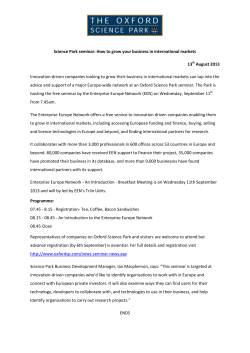
Problem solving is the communication that analyzes the problem in detail
Chapter 7 Solving Problems and Making Decisions Problem solving is the communication that analyzes the problem in detail before decision making Decision making is the communication that results in a choice Copyright c 2006 Oxford University Press 1 Decision-Making Skills Task skills • Problem recognition and framing, inference drawing, idea generation, argument Relational skills • Leadership, climate building, conflict management Procedural skills • Planning, process enactment Copyright c 2006 Oxford University Press 2 Decision-Making Principles 1. 2. 3. 4. Evolutionary process Circular rather than linear Individual-level and group-level influences affect decision making Decisions are made within system of internal and external constraints Copyright c 2006 Oxford University Press 3 Why Groups are More Effective Decision Makers Unlikely any individual will have all the knowledge or resources to make an effective decision Groups provide a greater diversity of perspectives Group provides the opportunity to test ideas before one is selected and implemented more Copyright c 2006 Oxford University Press 4 Why Groups are More Effective Decision Makers Quality of group communication affects members ability procedure quality solutions The social context motivates members to find best possible solution To take advantage of a group’s strengths, structure or decision making procedures are needed Copyright c 2006 Oxford University Press 5 Functional Theory of Decision Making Group decision procedures should help a group 1. 2. 3. 4. 5. Thoroughly discuss the problem Examine the criteria of an acceptable solution before discussing potential solutions Propose a set of alternative solutions Assess the positive aspects of each proposed solution Assess the negative aspects of each proposed solution Copyright c 2006 Oxford University Press 6 Why Use Decision-Making Procedures? Help to accomplish the five functions Overcome problems that routinely arise during decision making • Unequal participation • Trouble staying focused • Pressure to conform • Inefficient use of time • Difficulty of balancing task and relational dimensions Copyright c 2006 Oxford University Press 7 Ways in Which Decision Making Procedures Vary How group members contribute How much group members participate Whether participation is voluntary or forced Degree of formality Copyright c 2006 Oxford University Press 8 Decision Making Procedures 1. Standard agenda 2. Brainstorming 3. Nominal Group Technique 4. Consensus 5. Voting 6. Ranking Copyright c 2006 Oxford University Press 9 Standard Agenda Linear process of six steps 1. Identifying the problem 2. Analyzing the problem 3. Identifying minimal criteria for solution 4. Generating solutions 5. Evaluating solutions and selecting best one 6. Implementing the solution Copyright c 2006 Oxford University Press 10 Brainstorming Helps group generate ideas to improve productivity and creativity 1. 2. 3. 4. 5. State as many alternatives as possible Encourage creative ideas Examines ideas for improvement or combination Accept all ideas without criticism Evaluate ideas after idea generation is complete Copyright c 2006 Oxford University Press 11 Nominal Group Technique Independent idea generation phase 1. 2. Members silently write ideas Facilitator records ideas Interactive phase to discuss ideas 3. 4. 5. 6. Group discusses each for clarification Vote to narrow number of ideas Discuss ideas that received most votes Repeat steps 4 & 5 until one idea remains Copyright c 2006 Oxford University Press 12 Consensus Discussion to achieve agreement to support the group’s decision 1. One member facilitates the discussion 2. Facilitator uses discussion ideas to formulate proposals 3. Recorder writes down each proposal 4. Throughout discussion, recorder reads proposals 5. Recorder reads aloud final decision for approval or modification Copyright c 2006 Oxford University Press 13 Voting Group casts votes in support of or against a specific proposal 1. 2. 3. 4. Group members discuss to produce clear proposals Decide how vote will be taken Decide how many votes needed to decide an issue Restate proposal before voting Copyright c 2006 Oxford University Press 14 Ranking Reveal member preferences by assigning numerical value to each alternative 1. 2. 3. 4. Discuss ideas to produce clear proposals Each member assigns numerical value to each alternative Sum individual ranks; total for the group Read final decision aloud for approval or modification Copyright c 2006 Oxford University Press 15 Choosing a Procedure Select procedure or combination of procedures that: • Meets group’s communication needs • Satisfies five functions of group decision making Analyze type of task All member must agree to using a procedure for benefits to be achieved Copyright c 2006 Oxford University Press 16 Paradox of Using Procedures Procedures take time Members may resist using procedures if they are unaccustomed to using them • Practice can help • Tailor procedures to group’s needs • Consider an external facilitator to guide your group the use of a new procedure Copyright c 2006 Oxford University Press 17
© Copyright 2025





















